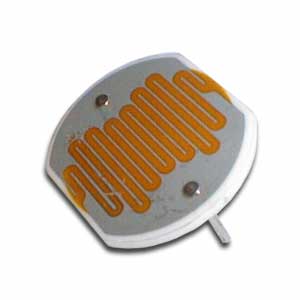
In this circuit, we’re going to use a special kind of resistor, called a CdS photocell to detect light and dark. When light is shined on the photocell, the LED will light up. When it is dark, the LED goes out. And with just a little light, the LED is dim. Remember the explanation of how a transistor works? We talked about having a small voltage (or current) control a larger one, kind of like turning the knob on a light switch dimmer in your house? That’s what this circuit is doing.
The photocell is a kind of resistor that changes it’s resistance depending on how light or dark it is. In this circuit, when it is light, the photocell delivers more current to the base lead of the transistor. When this happens, the transistor allows more voltage to flow from the emitter lead to the collector lead, which in turn lights up the LED. One resistor are simply used to reduce the amount of current that goes into the transistor (so it doesn’t get too much current) if the photocell has a really low resistance because of how much light is on it. The other one is called a pull-down resistor. Think of it like a door closer spring for electricity. A door closer closes the door when you let go of it (instead of leaving the door to sway in the wind). A pull-down resistor makes sure that when the transistor is “off”, it will “spring” toward a connection to the negative side of the battery (a pull-up makes it spring toward the positive).
Please login or register to read the rest of this content.
